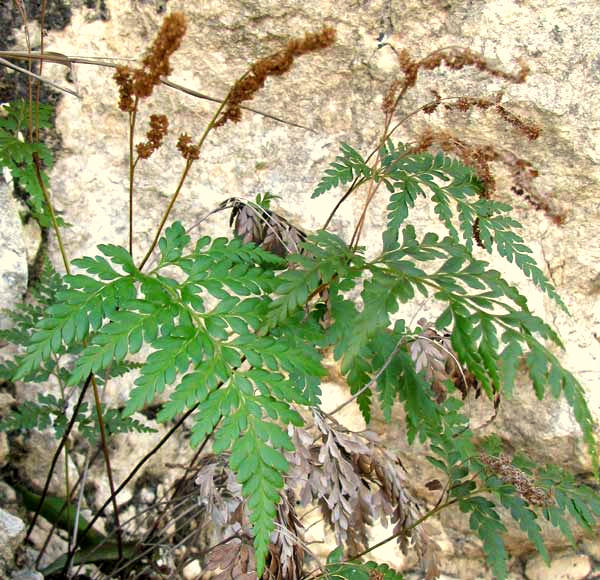Excerpts from Jim Conrad's
Naturalist Newsletter

from the December 26, 2010 Newsletter issued from Hacienda Chichen Resort beside Chichén Itzá Ruins, central Yucatán, MÉXICO; limestone bedrock, elevation ~39m (~128ft), ~N20.676°, ~W88.569°
PINE FERN IN A PINELESS LAND
Here's an important truth I've learned in this life: It's always a good idea to check out any bedrock outcropping in the area. Cracks and seams in weathered bedrock provide microhabitats unlike those of the surrounding area. Plants and animals capable of living there will display special adaptations for extremes of temperature, water availability, nutrient deficiencies and toxicities, extremes of lighting, and more.
So, I wasn't surprised the other day a few kms north of Pisté when I got off the bike and walked over to a limestone outcropping and found a species of fern not noticed here yet, the so-called Pine Fern, ANEMIA ADIANTIFOLIA, whose curious fronds are shown at the top of this page..
Northern fern-lovers will recognize similarities of the Pine Fern to the North's Rattlesnake Fern, Botrypus virginiana. Both species have thrice-pinnate, triangular fronds, and spores produced on brownish items poking skyward from the point of attachment of the green blade with its petiole. One profound difference between the two species is that Rattlesnake Fern fronds bear just one skyward-pointing thingy while Pine Ferns have two. Other more profound but less noticeable differences exist, because really the two species aren't closely related, being in different fern families. In fact the Flora of North America places the Pine Fern genus Anemia in its own family, the Anemiaceae.
Pine Fern fronds are three-times divided. First the frond is divided into three large segments. Of those three segments the first two bear spore-producing sporangia, and they form the two brown, sky-pointing parts of the fern. The center or outer of the three primary segments is sterile, and represents itself as a normal, frilly fern frond. Then each of these three segments is divided into separate segments, and then each of those segments is further divided, then each of those ultimate segments is lobed, but not further divided.
A close-up of a cluster of sporangia can be seen below:

Pine Fern sporangia are very different from last week's Asplenium sporangia. In last week's photo, remember how the drying, shrinking annulus ruptured the sporangium's walls? That microphotograph is still at www.backyardnature.net/n/10/101219sp.jpg.
Pine Fern sporangia are larger and a line of annulus cells lies along each side of each slit atop each spherical sporangium -- barely visible as beaded rims on the pores in our Pine Fern sporangium photo. Sporangia are formed with closed slits. As their annulus cells lose water and shrink the slits gape open and spores fall out.
Also in that photo, at the center, bottom you can see how the stalkless sporangia are attached to the undersurface of a brown blade segment, or pinna.
Back in Querétaro we met another Anemia species, Anemia phyllitidis, whose blade was only once-pinnate. You might enjoy comparing our Pine Fern with that one at www.backyardnature.net/mexnat/anemia.htm.
Though the genus Anemia is represented by only three species in North America, occurring in Texas and Florida, it's actually a fair-sized genus embracing around 117 species, with two centers of diversity -- 70 species in Brazil and 20 in Mexico.
Despite our fern being called the Pine Fern, no native pines occur here in the central Yucatan. They're called Pine Ferns in English because in Florida and on some English speaking Caribbean islands they do occur in pine woods. However, they also occur on limestone outcrops, as here, and open to lightly shaded rocky slopes from Mexico and Florida south to Ecuador and Brazil, always near sea level.